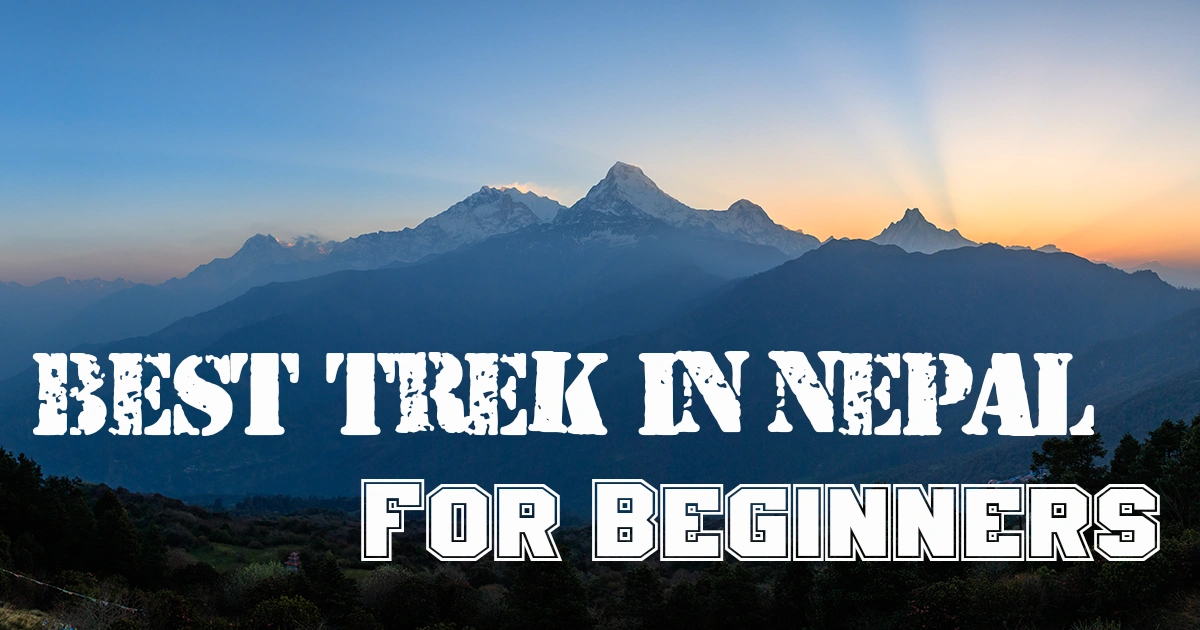If you’ve ever dreamed of trekking in the Himalayas but worried it might be too difficult, Nepal is the perfect place to start. While the country is world-famous for challenging adventures like the Everest Base Camp and Annapurna Circuit, not every trek demands weeks of endurance or extreme fitness. In fact, Nepal offers a range of beginner-friendly trails that blend stunning mountain views, rich cultural encounters, and manageable walking days, ideal for first-time trekkers.
As we move into 2025 and beyond, more travelers are seeking accessible adventures that provide both natural beauty and cultural depth without overwhelming physical demands. Whether you’re short on time, new to trekking, or simply looking for a less strenuous Himalayan journey, Nepal has plenty of options that will leave you equally inspired.
From the iconic sunrise views at Poon Hill to the serene valleys of Langtang and the quiet trails of Mardi Himal, these beginner treks open the door to the magic of Nepal. You’ll wander through rhododendron forests, meet warm-hearted locals in traditional villages, and soak up views of snow-capped giants, all without pushing beyond your comfort zone.
In this guide, we’ll walk you through the best treks in Nepal for beginners and first-time trekkers, complete with routes, costs, and tips to help you plan with confidence.
Why Choose Nepal for Your First Trek?
When it comes to trekking destinations, Nepal is unmatched. But what makes it such a great choice for beginners and first-time trekkers? Beyond the towering Himalayan peaks, Nepal offers a rare combination of accessibility, culture, and safety that makes stepping into trekking life far less intimidating.
Diverse Landscapes Within Reach
In Nepal, you don’t have to scale extreme heights to enjoy incredible scenery. Even beginner trails take you through lush forests, terraced fields, serene valleys, and charming villages, all with jaw-dropping Himalayan backdrops. Treks like Poon Hill or Helambu deliver million-dollar views without the strain of high-altitude expeditions.
Accessible Trails for All Fitness Levels
Whether you’re someone who enjoys weekend hikes or you’re just starting your fitness journey, Nepal has trails to match your pace. Routes vary from 3-day village walks to 10-day moderate treks, giving you the freedom to choose how much time and effort you want to commit.
Cultural Immersion Along the Way
Unlike many trekking destinations, Nepal’s trails are lived-in landscapes. You’ll encounter Gurung, Sherpa, Tamang, and Magar communities, each offering unique traditions, monasteries, and hospitality. Trekking here isn’t just about the mountains – it’s also about learning, connecting, and sharing moments with locals.
Teahouse Trekking: Comfortable & Affordable
For beginners, Nepal’s teahouse trekking system is a blessing. Instead of camping, you’ll stay in cozy family-run lodges with hot meals and warm beds, keeping your journey simple and budget-friendly. This allows you to travel light and focus on the experience rather than logistics.
Safe, Well-Established Trekking Routes
Nepal has some of the world’s best-marked and serviced trails, with guides and porters available at affordable rates. Beginner routes are well-traveled, meaning you’ll rarely feel isolated, and help is never too far away.
Tip: If you’re planning your very first trek, consider starting with a short, low-altitude route in the Annapurna or Langtang region. It’s the perfect way to test your stamina while still getting a taste of Nepal’s famous Himalayan magic.
Best Treks in Nepal for Beginners
Ghorepani Poon Hill Trek
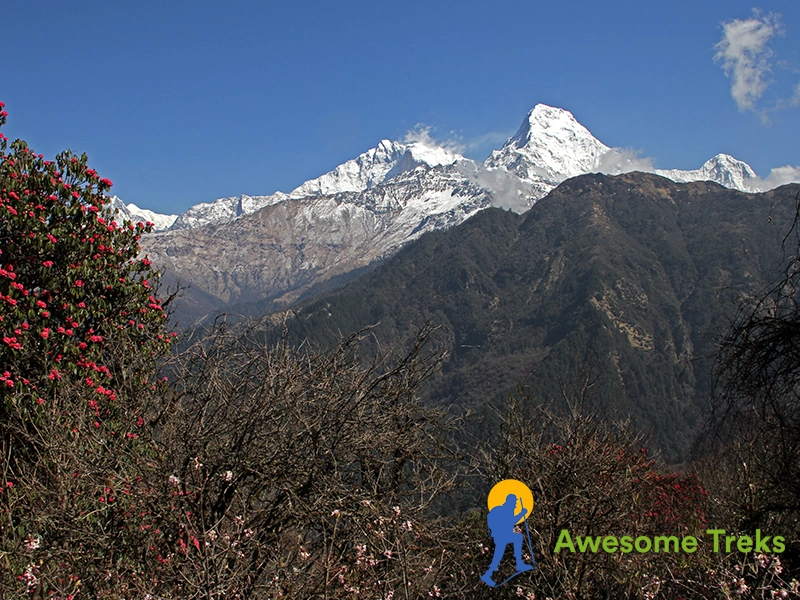
The Ghorepani Poon Hill Trek is often considered the ultimate beginner’s trek in Nepal. Short, scenic, and culturally rich, it offers everything a first-time trekker could hope for – majestic Himalayan views, welcoming villages, and trails that are accessible yet rewarding.
Duration & Difficulty
- Duration: 4-6 days depending on your pace and starting point (usually from Pokhara).
- Difficulty: Easy to moderate, with some steep ascents but no extreme altitudes. The highest point, Poon Hill (3,210m), is well within a comfortable range for beginners.
Highlights
- Sunrise at Poon Hill: The biggest draw of this trek is the unforgettable sunrise over the Annapurna and Dhaulagiri ranges. Watching the snow-capped giants glow gold and pink is a bucket-list moment.
- Charming Villages: Pass through Gurung and Magar settlements, where you’ll get to experience authentic village life and warm hospitality.
- Rhododendron Forests: In spring, the trail comes alive with blooming rhododendrons, creating a vibrant natural spectacle.
Why It’s Beginner-Friendly
- Short & Flexible: Perfect for those with limited time or new to trekking.
- Low Risk of Altitude Sickness: The elevation is relatively safe, making it ideal for first-timers concerned about acclimatization.
- Easy Access: Starting from Pokhara, it’s simple to reach the trailhead by road without needing domestic flights.
Estimated Costs
| Expense | Average Cost (USD) | Notes |
| Permits (ACAP & TIMS) | $30-50 | Required for entry |
| Accommodation | $5-10/night | Teahouses in villages |
| Meals | $3-7 per meal | Dal bhat is the go-to |
| Guide/Porter (Optional) | $25-35/day (guide), $15-25/day (porter) | Recommended for first-time trekkers |
Insider Tip
Wake up early (around 4:30 am) for the Poon Hill sunrise hike – it’s steep but short, and the reward is one of the most spectacular Himalayan views a beginner can experience.
Langtang Valley Trek

The Langtang Valley Trek is one of Nepal’s most accessible Himalayan adventures, making it a fantastic choice for beginners who want mountain views and cultural immersion without long travel days. Often called the “Valley of Glaciers,” Langtang offers stunning scenery, rich Tamang culture, and trails that are less crowded than those in the Everest or Annapurna regions.
Duration & Difficulty
- Duration: 7-10 days, depending on your chosen route and pace.
- Difficulty: Moderate. The trek involves gradual climbs and comfortable walking days, with the highest point around Kyanjin Gompa (3,870m).
Highlights
- Mountain Views: Breathtaking panoramas of Langtang Lirung (7,227m) and surrounding peaks.
- Kyanjin Gompa: A peaceful monastery village at the valley’s end, with opportunities to hike up to Kyanjin Ri or Tserko Ri for sunrise views.
- Cultural Experiences: The trail is dotted with Tamang and Tibetan-influenced villages, where you can enjoy yak cheese, butter tea, and traditional hospitality.
- Natural Beauty: Rhododendron forests, waterfalls, and grazing yak pastures make the trek scenic from start to finish.
Why It’s Beginner-Friendly
- Close to Kathmandu: The trailhead at Syabrubesi is just a 7-8 hour drive from the capital, eliminating the need for domestic flights.
- Gradual Altitude Gain: The trek allows for easier acclimatization compared to higher-altitude treks.
- Fewer Crowds: Compared to Everest and Annapurna, the Langtang Valley offers a quieter, more relaxed trekking experience.
Estimated Costs
| Expense | Average Cost (USD) | Notes |
| Permits (Langtang NP + TIMS) | $30-50 | Required for all trekkers |
| Accommodation | $5-12/night | Comfortable teahouses available |
| Meals | $3–8 per meal | Try local yak cheese specialties |
| Guide/Porter (Optional) | $25-35/day (guide), $15-25/day (porter) | Enhances safety and cultural learning |
| Transport | $10-15 by bus/jeep | From Kathmandu to Syabrubesi |
Insider Tip
Spend an extra night at Kyanjin Gompa. Use the day to hike up Kyanjin Ri (4,773m) for breathtaking views – an achievable climb even for beginners that rewards you with a 360° Himalayan panorama.
Mardi Himal Trek
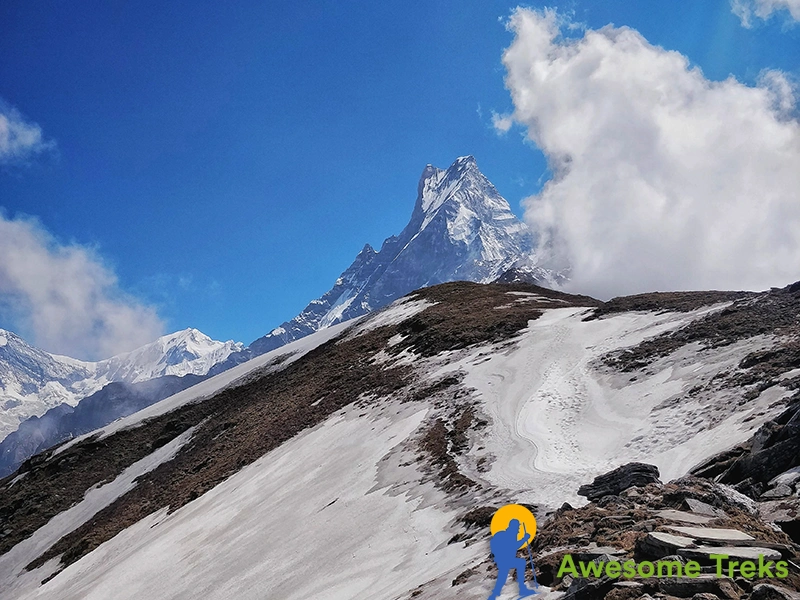
For first-time trekkers who want a quieter trail with equally stunning Himalayan views, the Mardi Himal Trek is a hidden gem. Tucked away in the Annapurna region, it’s one of Nepal’s newer trekking routes, offering a peaceful alternative to busier trails like Annapurna Base Camp. With breathtaking panoramas of Machapuchare (Fishtail Peak) and the Annapurna range, this trek is both accessible and rewarding.
Duration & Difficulty
- Duration: 5-7 days, depending on starting point and pace.
- Difficulty: Moderate. The trail involves some steep ascents but stays well below extreme altitudes, with the Mardi Himal Base Camp at 4,500m.
Highlights
- Close-Up Views: Stunning vistas of Machapuchare, Annapurna South, and Hiunchuli.
- Peaceful Trails: Far fewer trekkers compared to Poon Hill or Annapurna Base Camp, allowing for a more tranquil experience.
- Diverse Landscapes: Journey through lush forests, alpine meadows, and high ridges.
- Teahouse Experience: Simple but welcoming teahouses run by local families add warmth to the adventure.
Why It’s Beginner-Friendly
- Short & Manageable: Can be completed in under a week, perfect for travelers with limited time.
- Flexible Itineraries: The route can be extended or shortened depending on your fitness and interest.
- Moderate Altitude: While you’ll reach impressive heights, the gradual ascent makes it achievable for first-time trekkers.
Estimated Costs
| Expense | Average Cost (USD) | Notes |
| Permits (ACAP + TIMS) | $30-50 | Mandatory for entry |
| Accommodation | $6-12/night | Simple teahouses along the trail |
| Meals | $3-8 per meal | Dal bhat and noodle soup are staples |
| Guide/Porter (Optional) | $25-35/day (guide), $15-25/day (porter) | Highly recommended for navigation and comfort |
| Transport | $10-20 | Bus/jeep from Pokhara to trailhead (Kande or Phedi) |
Insider Tip
Try to time your trek during spring (March-May) when rhododendrons are in bloom. The vibrant forests, combined with clear skies and snow-capped peaks, make Mardi Himal one of the most photogenic beginner treks in Nepal.
Helambu Trek
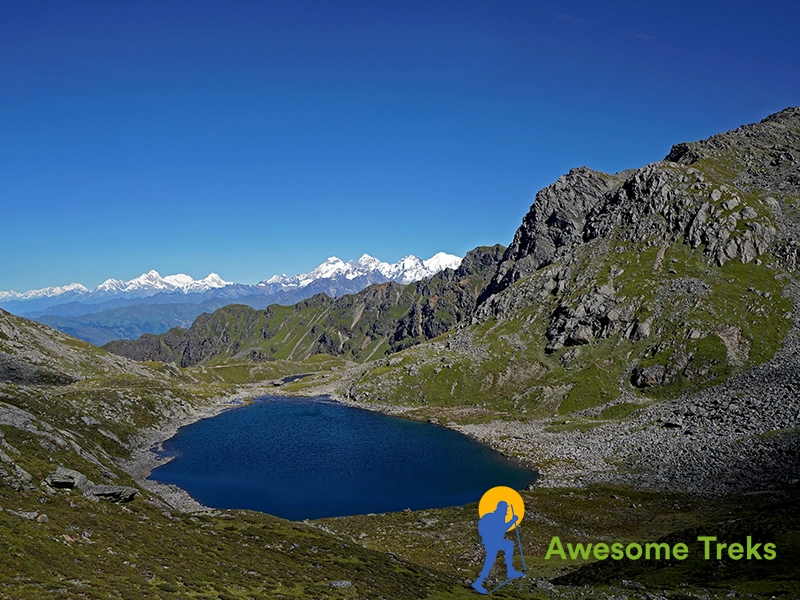
If you’re short on time but eager to experience Nepal’s Himalayan culture and landscapes, the Helambu Trek is an excellent choice for beginners. Located just north of Kathmandu, this trek combines easy accessibility with authentic encounters in Sherpa and Tamang villages, making it a cultural as well as scenic introduction to trekking in Nepal.
Duration & Difficulty
- Duration: 6-8 days, depending on your pace and chosen route.
- Difficulty: Easy to moderate, with gentle ascents and descents. The highest point is usually Tharepati (3,650m), which remains comfortable for most beginners.
Highlights
- Cultural Richness: Home to Hyolmo (Helambu Sherpa) people, the trek offers unique insights into their traditions, monasteries, and Buddhist practices.
- Scenic Landscapes: Walk through rhododendron forests, rivers, and terraced farmlands, with Himalayan peaks like Langtang Lirung visible in the distance.
- Proximity to Kathmandu: Since the trailhead is only a short drive away, you save time and money on transportation.
- Less Crowded: Compared to Annapurna or Everest regions, Helambu remains relatively quiet, providing a relaxed trekking atmosphere.
Why It’s Beginner-Friendly
- Close to the Capital: No long journeys or flights needed – ideal if you want a quick start.
- Lower Altitude: With trails mostly below 3,650m, the risk of altitude sickness is very low.
- Short & Flexible: You can tailor the trek to fit your schedule, making it perfect for beginners or those with limited vacation time.
Estimated Costs
| Expense | Average Cost (USD) | Notes |
| Permits (Langtang NP + TIMS) | $30-50 | Required for trekking |
| Accommodation | $5-10/night | Comfortable teahouses in villages |
| Meals | $3-8 per meal | Dal bhat, noodles, and soups are common |
| Guide/Porter (Optional) | $25-35/day (guide), $15-25/day (porter) | Adds cultural insights and support |
| Transport | $5-15 | Local bus/jeep from Kathmandu to Sundarijal or Melamchi |
Insider Tip
Consider spending extra time in Tarkeghyang or Sermathang, two of the most culturally vibrant villages in Helambu. You’ll experience warm hospitality, taste traditional dishes, and learn about local Buddhist traditions, all without venturing too high into the mountains.
Royal Trek
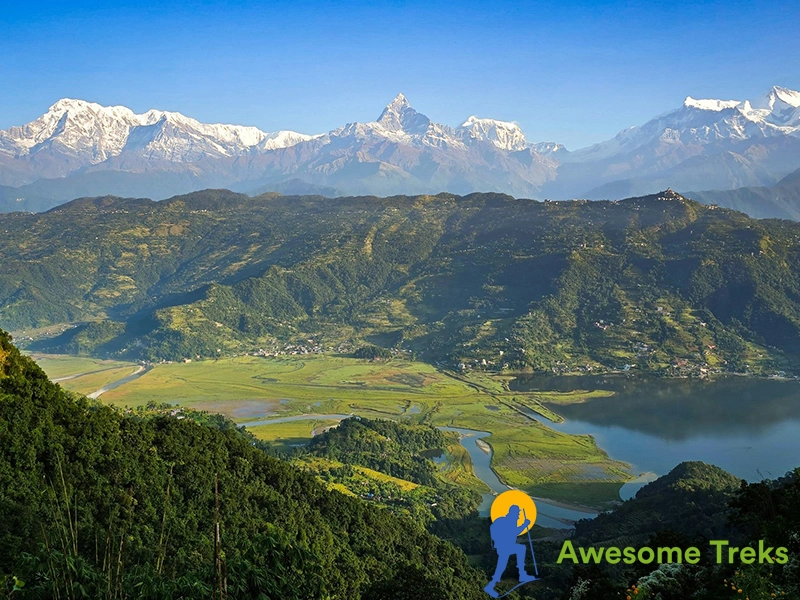
The Royal Trek is one of the shortest and easiest trekking routes in Nepal, making it a top choice for beginners and first-time trekkers. The trek earned its name after Prince Charles and his entourage famously walked this trail in the early 1980s. Today, it remains a scenic and culturally rich experience, ideal for those who want a taste of the Himalayas without strenuous climbs or long days.
Duration & Difficulty
- Duration: 3-5 days, depending on your pace.
- Difficulty: Easy, with gentle terrain and modest altitude gain (maximum elevation around 1,730m).
Highlights
- Panoramic Views: On clear days, you’ll see Annapurna I, Machapuchare (Fishtail), Dhaulagiri, and Lamjung Himal – spectacular Himalayan scenery without the need for high-altitude trekking.
- Cultural Encounters: The trail passes through Gurung villages, where you can observe traditional lifestyles, architecture, and warm hospitality.
- Quiet Trails: Unlike Everest or Annapurna Base Camp, this trek is less crowded, offering peace and tranquility.
- Accessible Start Point: The trek begins near Pokhara, Nepal’s adventure hub, so you can combine it with a relaxing lakeside stay before or after your trek.
Why It’s Beginner-Friendly
- Short Duration: With just 3-5 days, it’s manageable for those new to trekking.
- Low Altitude: No risks of altitude sickness since the route stays below 2,000m.
- Easy Terrain: Wide, gradual trails make it suitable for families, older trekkers, or anyone seeking a relaxed pace.
Estimated Costs
| Expense | Average Cost (USD) | Notes |
| Permits (ACAP + TIMS) | $30-50 | Required for trekking |
| Accommodation | $5-10/night | Teahouses or homestays |
| Meals | $3-7 per meal | Simple but hearty Nepali food |
| Guide/Porter (Optional) | $25-35/day (guide), $15-25/day (porter) | Helpful for cultural insights |
| Transport | $10-20 | Local transport from Pokhara to trailhead |
Insider Tip
Because of its short duration, the Royal Trek pairs perfectly with Pokhara sightseeing. After the trek, treat yourself to a boat ride on Phewa Lake, visit the World Peace Pagoda, or enjoy a café with mountain views – making your beginner trekking adventure even more rewarding.
Everest View Trek
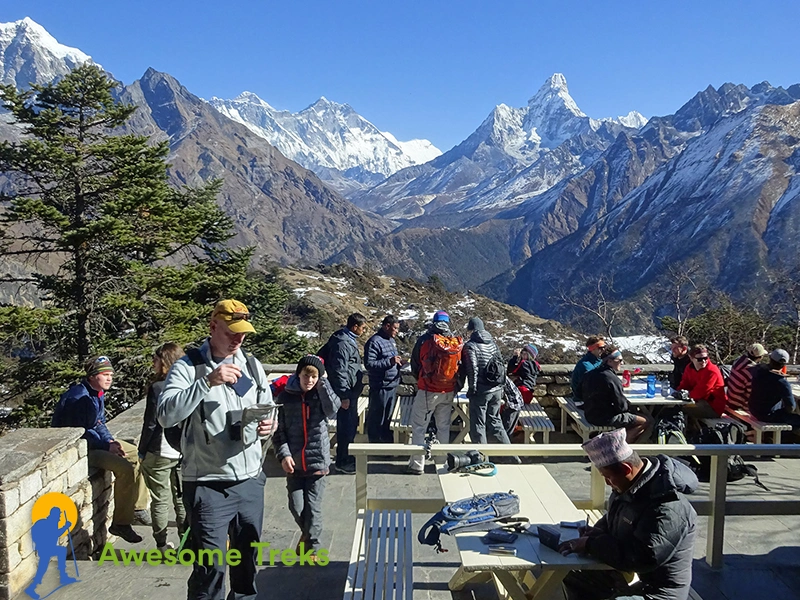
If you’ve always dreamed of seeing Mount Everest up close but aren’t ready for the physical demands of the Everest Base Camp trek, the Everest View Trek is the perfect alternative. It’s a short, beginner-friendly route that takes you into the heart of the Khumbu region, offering unforgettable Himalayan views, Sherpa culture, and iconic landmarks – all without the extreme challenge of high-altitude trekking.
Duration & Difficulty
- Duration: 5-7 days
- Difficulty: Easy to moderate, with gradual ascents. The highest point is Everest View Hotel (3,880m), which is safe for most beginners but still requires acclimatization.
Highlights
- Everest Panorama: From the Everest View Hotel, you can see Everest, Lhotse, Ama Dablam, Thamserku, and more in a single sweep.
- Sherpa Culture: Visit Namche Bazaar, the bustling hub of the Khumbu, and explore Tengboche Monastery, one of the most important Buddhist sites in the region.
- Accessible Adventure: The trek begins with a short flight to Lukla, giving you a thrilling entry into the Himalayas.
- Combination of Comfort & Adventure: Teahouses here are well-developed, and Namche even offers bakeries, cafés, and gear shops.
Why It’s Beginner-Friendly
- Short & Manageable: Unlike the 12-14 day EBC trek, this route is completed in under a week.
- Moderate Altitude: You’ll experience the thrill of trekking at higher elevations without going beyond 4,000m.
- Well-Established Trail: The paths are well-trodden, with plenty of teahouses and facilities.
Estimated Costs
| Expense | Average Cost (USD) | Notes |
| Permits (Sagarmatha NP + TIMS) | $50-60 | Mandatory for entry |
| Accommodation | $6-12/night | Teahouses with basic comfort |
| Meals | $5-10 per meal | Prices rise with altitude |
| Guide/Porter (Optional) | $30-40/day (guide), $20-25/day (porter) | Enhances safety and cultural learning |
| Flight (Kathmandu to Lukla round trip) | $200-400 | Major cost of the trek |
Insider Tip
Spend at least two nights in Namche Bazaar for acclimatization. Use your rest day to hike to Everest View Hotel or Khunde and Khumjung villages, not only will you enjoy stunning panoramas, but you’ll also reduce the risk of altitude sickness while soaking in Sherpa heritage.
Estimated Costs for Beginner Treks in Nepal
Planning a trek in Nepal is exciting, but understanding the costs beforehand helps first-time trekkers budget effectively. Costs vary depending on the trail, duration, choice of accommodation, and whether you hire a guide or porter. Below is a detailed breakdown to help you plan your beginner-friendly adventure.
Trekking Permits & Fees
| Permit | Cost (USD) | Notes |
| TIMS Card (Trekkers’ Information Management System) | $10–20 | Required for all trekkers |
| National Park Fees | $30–50 | Annapurna, Langtang, and Sagarmatha NP require entry permits |
| Special Permits | $500+ | Only for remote areas like Upper Mustang; not needed for beginner treks |
Accommodation & Meals
Most beginner treks follow the teahouse system, providing simple rooms and meals along the trail.
| Expense | Average Cost (USD) | Notes |
| Accommodation | $5-12/night | Teahouses vary by region and altitude |
| Meals | $3-8 per meal | Dal bhat, noodle soup, and momos are common |
| Snacks & Drinks | $1-3 per item | Hot drinks and energy bars are widely available |
Guides & Porters (Optional but Recommended)
Hiring a guide or porter can enhance safety and cultural experience, especially for first-time trekkers.
| Service | Average Cost (USD/day) | Notes |
| Guide | $25-35 | Knowledgeable guides provide navigation, safety, and cultural insight |
| Porter | $15-25 | Helps carry luggage, making trekking easier |
Transportation
Getting to trailheads varies by region:
- Pokhara to trailhead: $10-20 by local bus or jeep
- Kathmandu to Lukla (Everest region): $200-400 round-trip flight
- Kathmandu to Syabrubesi (Langtang): $10-15 by bus or jeep
Gear & Miscellaneous
- Trekking clothing, boots, sleeping bags, and trekking poles: $200-500 if buying new (rentals are available for cheaper).
- Travel insurance covering medical emergencies and trekking activities is highly recommended ($50-100 for a short trek).
Insider Tip
For beginners, keeping a daily budget of $30-50 per person (excluding flights to Lukla) is reasonable. This covers accommodation, meals, and minor expenses while ensuring comfort and flexibility.
Practical Tips for First-Time Trekkers
Embarking on your first trek in Nepal can be exciting, but preparation is key to making it enjoyable and safe. These practical tips will help first-time trekkers navigate trails, stay healthy, and fully enjoy the Himalayan experience.
Physical Preparation
Even beginner treks require moderate fitness. Start 2-3 months before your trip with:
- Cardio exercises like walking, jogging, or cycling to build stamina.
- Hiking practice on local trails or stairs with a backpack.
- Strength training for legs, core, and back to handle uphill walks and carrying small loads.
Best Trekking Seasons
- Spring (March-May): Clear skies, blooming rhododendrons, and moderate temperatures.
- Autumn (September-November): Stable weather, crisp mountain views, and festive local culture.
- Avoid monsoon season (June-August) due to landslides, leeches, and slippery trails, and winter (December-February) for beginner treks, except lower-altitude routes like Helambu.
Packing Essentials
- Clothing: Layered clothing, waterproof jacket, thermal wear, trekking pants, and hats/gloves.
- Footwear: Sturdy trekking boots and comfortable socks.
- Gear: Trekking poles, headlamp, reusable water bottle, sunscreen, sunglasses.
- Medical kit: Basic first aid, altitude sickness medicine, and any personal medication.
Safety & Acclimatization
- Acclimatize gradually to avoid altitude sickness; never rush to higher elevations.
- Hydrate frequently and eat energy-rich meals.
- Hire a guide for remote areas or high-altitude treks.
- Always check the weather forecast and be prepared to adjust your itinerary if conditions worsen.
Respect Local Culture
- Dress modestly, especially in villages and monasteries.
- Greet locals politely with “Namaste” and ask before taking photographs.
- Support local businesses by purchasing meals, souvenirs, or services along the trail.
Miscellaneous Tips
- Carry cash in small denominations; ATMs are rare on trails.
- Keep a copy of your passport, permits, and insurance.
- Travel light; aim for a backpack under 12-15 kg.
Insider Tip
Even on beginner treks, take your time to soak in the scenery and culture. The Himalayas are about the journey as much as the destination, so pace yourself, enjoy the local interactions, and take plenty of photos to capture your first Himalayan adventure.
Conclusion
Nepal’s beginner treks offer the perfect blend of stunning scenery, rich culture, and accessibility – making the Himalayas approachable for first-time trekkers. From the iconic sunrise at Poon Hill and peaceful trails of Helambu to the panoramic views of Everest from Namche, these routes provide a safe yet inspiring introduction to trekking life. You don’t need weeks of experience or extreme fitness to embark on these journeys, just curiosity, preparation, and an adventurous spirit.
For first-time trekkers, these trails are more than just walks through the mountains, they’re an opportunity to connect with local communities, witness breathtaking landscapes, and create memories that last a lifetime. Every step on these trails builds confidence and opens the door to longer or more challenging adventures in the future.
As you plan your first trek in Nepal, consider booking early and checking itineraries for 2025 or 2026 to secure accommodations, guides, and permits. Take the first step, embrace the adventure, and let Nepal’s majestic peaks inspire your journey into trekking for years to come.
Frequently Asked Questions (FAQs)
Which treks in Nepal are suitable for beginners?
Beginner-friendly treks include Ghorepani Poon Hill, Langtang Valley, Mardi Himal, Helambu, Royal Trek, and Everest View Trek. These routes offer moderate distances, manageable altitudes, and scenic beauty.
How long do beginner treks usually take?
Most beginner treks last 3-10 days, depending on the route. Short treks like the Royal Trek can be completed in 3-5 days, while longer ones like Langtang take about 7-10 days.
Do I need a guide or porter for beginner treks?
Guides and porters are optional on easy trails but highly recommended for safety, navigation, and cultural insights, especially for first-time trekkers.
What is the best time of year for beginner treks?
Spring (March-May) and Autumn (September-November) are ideal, offering clear skies, moderate temperatures, and beautiful landscapes.
How difficult are beginner treks?
Difficulty ranges from easy to moderate. Trails are manageable, with gradual ascents and altitudes typically below 4,000 meters.
Can beginners experience altitude sickness?
Altitude sickness risk is low on beginner treks but can occur above 3,500m. Acclimatize gradually, stay hydrated, and listen to your body.
Are teahouses available on beginner trekking routes?
Yes, most beginner trails feature teahouses or lodges offering basic rooms and meals, making accommodation simple and comfortable.
What kind of food is available on trails?
Common options include dal bhat, noodles, momos, soups, and tea, with vegetarian options widely available.
Can I trek solo as a beginner?
Solo trekking is possible on popular beginner routes, but hiring a guide is recommended for safety and local knowledge.
How much does a beginner trek cost?
Expect $30-50 per day for accommodation, meals, and minor expenses. Flights, permits, guides, and porters are additional costs.
Are beginner treks family-friendly?
Yes, treks like Royal Trek, Helambu, and Poon Hill are suitable for families, older travelers, and children with moderate fitness.
Do I need trekking insurance?
Yes, insurance covering medical emergencies and trekking activities is strongly recommended for safety.
How should beginners prepare physically?
Engage in cardio, hiking practice, and strength exercises for legs and core. Short hikes with a backpack are excellent preparation.
What gear is essential for a beginner trek?
Essentials include sturdy trekking boots, layered clothing, waterproof jacket, trekking poles, water bottle, and first-aid kit.
How do I reach trailheads for beginner treks?
Trailheads are usually accessible by bus, jeep, or short flights. For example, Poon Hill starts near Pokhara, Langtang from Syabrubesi, and Everest View from Lukla.
Are the trails safe for beginners?
Yes, well-marked beginner trails are generally safe, with teahouses and fellow trekkers along the way. Guides add extra security.
Can beginners experience local culture?
Absolutely. Trails pass through Gurung, Tamang, and Sherpa villages, offering cultural immersion, monasteries, and traditional meals.
How should beginners pace themselves on a trek?
Walk slowly, take regular breaks, and listen to your body. Avoid rushing to prevent fatigue or altitude issues.
Is cash needed on the trail?
Yes, carry Nepalese rupees in small denominations for teahouses, snacks, and minor purchases, as ATMs are scarce.
Can I combine beginner treks with sightseeing?
Definitely. Many treks start or end near Pokhara or Kathmandu, allowing for sightseeing at lakes, temples, or cultural landmarks before or after your trek.
